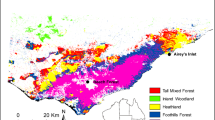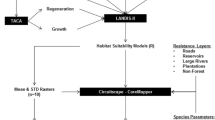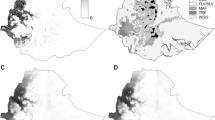Abstract
The current challenge in a context of major environmental changes is to anticipate the responses of species to future landscape and climate scenarios. In the Mediterranean basin, climate change is one the most powerful driving forces of fire dynamics, with fire frequency and impact having markedly increased in recent years. Species distribution modelling plays a fundamental role in this challenge, but better integration of available ecological knowledge is needed to adequately guide conservation efforts. Here, we quantified changes in habitat suitability of an early-succession bird in Catalonia, the Dartford Warbler (Sylvia undata), which is globally evaluated as Near Threatened in the IUCN Red List. We assessed potential changes in species distributions between 2000 and 2050 under different fire management and climate change scenarios, and described landscape dynamics using a spatially-explicit fire-succession model that simulates fire impacts in the landscape and post-fire regeneration (MEDFIRE model). Dartford Warbler occurrence data were acquired at two different spatial scales from: (1) the Atlas of European Breeding Birds (EBCC) and (2) the Catalan Breeding Bird Atlas (CBBA). Habitat suitability was modelled using five widely-used modelling techniques in an ensemble forecasting framework. Our results indicated considerable habitat suitability losses (ranging between 47 and 57 % in baseline scenarios), which were modulated to a large extent by fire regime changes derived from fire management policies and climate changes. Such result highlighted the need for taking the spatial interaction between climate changes, fire-mediated landscape dynamics and fire management policies into account for coherently anticipating habitat suitability changes of early-succession bird species. We conclude that fire management programs need to be integrated into conservation plans to effectively preserve sparsely forested and early succession habitats and their associated species in the face of global environmental change.




Similar content being viewed by others
References
Abbas D, Current D, Ryans M et al (2011) Harvesting forest biomass for energy—an alternative to conventional fuel treatments: trials in the Superior National Forest, USA. Biomass Bioenerg 35:4557–4564. doi:10.1016/j.biombioe.2011.06.030
Araújo MB, New M (2007) Ensemble forecasting of species distributions. Trends Ecol Evol 22:42–47. doi:10.1016/j.tree.2006.09.010
Arcos JM, Bécares J, Villero D et al (2012) Assessing the location and stability of foraging hotspots for pelagic seabirds: an approach to identify marine Important Bird Areas (IBAs) in Spain. Biol Conserv 156:30–42. doi:10.1016/j.biocon.2011.12.011
Becker DR, Larson D, Lowell EC (2009) Financial considerations of policy options to enhance biomass utilization for reducing wildfire hazards. For Policy Econ 11:628–635. doi:10.1016/j.forpol.2009.08.007
Bibby CJ (1978) Conservation of the Dartford Warbler on english lowland heaths: A review. Biol Conserv 13(4):299–307
Birdlife International (2004a) Birds in the European Union: a status assessment. BirdLife International, Wageningen
Birdlife International (2004b) Birds in Europe: population estimates, trends and conservation status. BirdLife International, Cambridge
Birdlife International (2014) Species factsheet: Sylvia undata. Downloaded from http://www.birdlife.org on 07/10/2014
Breiman L (2001) Random forests. Mach Learn 45:5–32
Breiman L, Friedman JH, Olshen RA, Stone CJ (1984) Classification and regression trees. Wadsworth, California
Brotons L, Pons P, Herrando S (2005) Colonization of dynamic Mediterranean landscapes: where do birds come from after fire? J Biogeogr 32:789–798. doi:10.1111/j.1365-2699.2004.01195.x
Brotons L, Aquilué N, de Cáceres M et al (2013) How fire history, fire suppression practices and climate change affect wildfire regimes in Mediterranean landscapes. PLoS ONE 8:e62392. doi:10.1371/journal.pone.0062392
Clavero M, Villero D, Brotons L (2011) Climate change or land use dynamics: do we know what climate change indicators Indicate? PLoS ONE 6:8
Cook CN, Inayatullah S, Burgman Ma et al (2014) Strategic foresight: how planning for the unpredictable can improve environmental decision-making. Trends Ecol Evol. doi:10.1016/j.tree.2014.07.005
Cumming SG, Stralberg D, Lefevre KL, et al. (2013) Climate and vegetation hierarchically structure patterns of songbird distribution in the Canadian boreal region. Ecography 37:137-151. doi: 10.1111/j.1600-0587.2013.00299.x
De Cáceres M, Brotons L, Aquilué N, Fortin M-J (2013) The combined effects of land-use legacies and novel fire regimes on bird distributions in the Mediterranean. J Biogeogr 40:1535–1547. doi:10.1111/jbi.12111
De Chazal J, Rounsevell MDA (2009) Land-use and climate change within assessments of biodiversity change: a review. Glob Environ Change 19:306–315. doi:10.1016/j.gloenvcha.2008.09.007
Díaz-Delgado R, Lloret F, Pons X (2004) Spatial patterns of fire occurrence in Catalonia, NE, Spain. Landsc Ecol 19:731–745
Elith J, Ferrier S, Huettmann F, Leathwick J (2005) The evaluation strip: a new and robust method for plotting predicted responses from species distribution models. Ecol Modell 186:280–289. doi:10.1016/j.ecolmodel.2004.12.007
Elith J, Graham CH, Anderson RP et al (2006) Novel methods improve prediction of species’ distributions from occurrence data. Ecography (Cop) 2:129–151
Estrada J, Pedrocchi V, Brotons L, Herrando S (2004) Catalan breeding bird atlas (1999–2002). Institut Catala d’Ornitologia, Lynx, Barcelona
Evans AM, Finkral AJ (2009) From renewable energy to fire risk reduction: a synthesis of biomass harvesting and utilization case studies in US forests. GCB Bioenergy 1:211–219. doi:10.1111/j.1757-1707.2009.01013.x
Fenton N, Béscond H, Imbeau L, Boudreault C, Drapeau P, Bergeron Y (2009) Silvicultural and ecological evaluation of partial harvest in the boreal forest on the Clay Belt, Québec. In: Gauthier S, Vaillancourt MA, Leduc A, De Grandpré L, Kneeshaw D, Morin H, Drapeau P, Bergeron Y, Ecosystem management in the boreal forest. Les Presses de l’Université du Québec, Québec, pp 393–415
Friedman JH, Hastie T, Tibshirani R (2000) Additive logistic regression: a statistical view of boosting. Ann Stat 28:337–374
Garcia Ra, Cabeza M, Rahbek C, Araújo MB (2014) Multiple dimensions of climate change and their implications for biodiversity. Science 344:1247579. doi:10.1126/science.1247579
Gil-Tena A, Brotons L, Saura S (2009) Mediterranean forest dynamics and forest bird distribution changes in the late 20th century. Glob Change Biol 15:474–485. doi:10.1111/j.1365-2486.2008.01730.x
Guisan A, Rahbek C (2011) SESAM—a new framework integrating macroecological and species distribution models for predicting spatio-temporal patterns of species assemblages. J Biogeogr 38:1433–1444. doi:10.1111/j.1365-2699.2011.02550.x
Guisan A, Thuiller W (2005) Predicting species distribution: offering more than simple habitat models. Ecol Lett 8:993–1009. doi:10.1111/j.1461-0248.2005.00792.x
Hagemeijer EJM, Blair MJ (1997) The EBCC atlas of European breeding birds: their distribution and abundance. Poyser, London
Hastie T, Tibshirani R (1990) Generalized additive models. Chapman and Hall, London
Herrando S, Brotons L (2002) Forest bird diversity in Mediterranean areas affected by wildfires: a multi-scale approach. Ecography (Cop) 25:161–172. doi:10.1034/j.1600-0587.2002.250204.x
Herrando S, Amo R, Brotons L, Llacuna S (2001) Factors influencing post-fire dynamics of Sardinian and Dartford Warblers in Mediterranean shrublands. Ornis Fenn 78:168–174
Herrando S, Brotons L, Estrada J et al (2011) Catalan winter bird atlas 2006–2009. Institut Català d’Ornitologia, Barcelona
Herrando S, Anton M, Sardà-Palomera F et al (2014) Indicators of the impact of land use changes using large-scale bird surveys: land abandonment in a Mediterranean region. Ecol Indic 45:235–244. doi:10.1016/j.ecolind.2014.04.011
Hirzel A, Guisan A (2002) Which is the optimal sampling strategy for habitat suitability modelling. Ecol Modell 157:331–341. doi:10.1016/S0304-3800(02)00203-X
Houtman RM, Montgomery CA, Gagnon AR et al. (2013) Allowing a wildfire to burn: estimating the effect on future fire suppression costs. Int J Wildl Fire 22:871–882. doi: http://dx.doi.org/10.1071/WF12157
Huntley B, Green RE, Collingham YC, Willis SG (2007) A climatic atlas of European breeding birds. Lynx, Barcelona
IPCC (2007) Climate Change 2007: synthesis report. Contribution of Working Groups I, II and III to the Fourth Assessment Report of the Intergovernmental Panel on Climate Change. IPCC, Geneva
Keeley J, Bond W, Bradstock R, et al. (2012) Fire in mediterranean ecosystems: ecology, evolution and management. Cambridge University Press, Cambridge, UK
Kelly LT, Bennett AF, Clarke MF, McCarthy Ma (2014) Optimal fire histories for biodiversity conservation. Conserv Biol 00:1–9. doi:10.1111/cobi.12384
King DI, Schlossberg S, Brooks RT, Akresh ME (2011) Effects of fuel reduction on birds in pitch pine–scrub oak barrens of the United States. For Ecol Manag 261:10–18. doi:10.1016/j.foreco.2010.08.039
Lindenmayer DB, Blanchard W, McBurney L et al. (2014) Complex responses of birds to landscape-level fire extent, fire severity and environmental drivers. Divers Distrib. doi: 10.1111/ddi.12172
Lloret F, Calvo E, Pons X, Díaz-delgado R (2002) Wildfires and landscape patterns in the Eastern Iberian Peninsula. Landsc Ecol 17:745–759
Lomba A, Pellissier L, Randin C et al (2010) Overcoming the rare species modelling paradox: a novel hierarchical framework applied to an Iberian endemic plant. Biol Conserv 143:2647–2657. doi:10.1016/j.biocon.2010.07.007
Loyn RH (1997) Effects of an extensive wildfire on birds in far eastern Victoria. Pac Conserv Biol 3:221–234
Marmion M, Parviainen M, Luoto M et al (2009) Evaluation of consensus methods in predictive species distribution modelling. Divers Distrib 15:59–69. doi:10.1111/j.1472-4642.2008.00491.x
Martí R, Del Moral JC (eds) (2003) Atlas de las Aves Reproductoras de España. Dirección General de Conservación de la Naturaleza-Sociedad Española de Ornitología, Madrid
McCullagh P, Nelder JA (1989) Generalized linear models. Chapman and Hall, London
Moreira F, Delgado A, Ferreira S et al (2003) Effects of prescribed fire on vegetation structure and breeding birds in young Pinus pinaster stands of northern Portugal. For Ecol Manag 184:225–237. doi:10.1016/S0378-1127(03)00214-7
Moreira F, Viedma O, Arianoutsou M et al (2011) Landscape–wildfire interactions in southern Europe: implications for landscape management. J Environ Manag 92:2389–2402. doi:10.1016/j.jenvman.2011.06.028
Nimmo DG, Kelly LT, Spence-Bailey LM et al (2012) Predicting the century-long post-fire responses of reptiles. Glob Ecol Biogeogr 21:1062–1073. doi:10.1111/j.1466-8238.2011.00747.x
Pearson RG, Dawson TP, Liu C (2004) Modelling species distributions in Britain: a hierarchical integration of climate and land-cover data. Ecography (Cop) 3:285–298
Pons P, Clavero M (2010) Bird responses to fire severity and time since fire in managed mountain rangelands. Anim Conserv 13:294–305. doi:10.1111/j.1469-1795.2009.00337.x
Pons P, Prodon R (1996) Short term temporal patterns in a Mediterranean shrubland bird community after wildfire. Acta Oecol 17:29–41
Pons P, Clavero M, Bas JM, Prodon R (2012) Time-window of occurrence and vegetation cover preferences of Dartford and Sardinian Warblers after fire. J Ornithol 153:921–930. doi:10.1007/s10336-012-0822-6
PECBMS (2013) Population trends of common European breeding birds. CSO, Prague. Available at http://www.ebcc.info/wpimages/video/Leaflet2013.pdf
Regos A, Aquilué N, Retana J et al (2014) Using unplanned fires to help suppressing future large fires in Mediterranean forests. PLoS ONE 9:e94906. doi:10.1371/journal.pone.0094906
Richards SA, Possingham HP, Tizard J (1999) Optimal fire management for maintaining community diversity. Ecol Appl 9:880–892
Rodrigo A, Retana J, Pico FX (2004) Direct regeneration is not the only response of Mediterranean forest to large fires. Ecology 85:716–729
Rost J, Clavero M, Brotons L, Pons P (2012) The effect of postfire salvage logging on bird communities in Mediterranean pine forests: the benefits for declining species. J Appl Ecol 49:644–651. doi:10.1111/j.1365-2664.2012.02127.x
Rost J, Hutto RL, Brotons L, Pons P (2013) Comparing the effect of salvage logging on birds in the Mediterranean basin and the rocky mountains: common patterns, different conservation implications. Biol Conserv 158:7–13
Santos X, Mateos E, Bros V et al (2014) Is response to fire influenced by dietary specialization and mobility? A comparative study with multiple animal assemblages. PLoS ONE 9:e88224. doi:10.1371/journal.pone.0088224
SEO/BirdLife (2010) Estado de conservación de las aves en España. SEO/BirdLife, Madrid
Shirihai H, Gargallo G, Helbig AJ (2001) Sylvia warblers: identification, taxonomy and phylogeny of the genus Sylvia. Christopher Helm Publishers Ltd, London
Stephens SL (1998) Evaluation of the effects of silvicultural and fuels treatments on potential fire behaviour in Sierra Nevada mixed-conifer forests. For Ecol Manag 105:21–35. doi:10.1016/S0378-1127(97)00293-4
Stralberg D, Matsuoka SM, Hamann A et al (2014) Projecting boreal bird responses to climate change: the signal exceeds the noise. Ecol Appl. doi:10.1890/13-2289.1
Taylor RS, Watson SJ, Bennett AF, Clarke MF (2013) Which fire management strategies benefit biodiversity? A landscape-perspective case study using birds in mallee ecosystems of south-eastern Australia. Biol Conserv 159:248–256. doi:10.1016/j.biocon.2012.12.005
Thuiller W (2003) BIOMOD—optimizing predictions of species distributions and projecting potential future shifts under global change. Glob Change Biol 9:1353–1362. doi:10.1046/j.1365-2486.2003.00666.x
Thuiller W, Lafourcade B, Engler R, Araújo MB (2009) BIOMOD—a platform for ensemble forecasting of species distributions. Ecography (Cop) 32:369–373. doi:10.1111/j.1600-0587.2008.05742.x
Tucker GM, Heath MF (1994) Birds in Europe: their conservation status. BirdLife International, Cambridge
Turco M, Llasat M-C, von Hardenberg J, Provenzale A (2014) Climate change impacts on wildfires in a Mediterranean environment. Clim Change 125:369–380. doi:10.1007/s10584-014-1183-3
Vallecillo S, Brotons L, Herrando S (2007) Assessing the response of open-habitat bird species to landscape changes in Mediterranean mosaics. Biodivers Conserv 17:103–119. doi:10.1007/s10531-007-9233-z
Van den Berg LJL, Bullock JM, Clarke RT et al (2001) Territory selection by the Dartford warbler (Sylvia undata) in Dorset, England: the role of vegetation type, habitat fragmentation and population size. Biol Conserv 101:217–228. doi:10.1016/S0006-3207(01)00069-6
Watson SJ, Taylor RS, Nimmo DG et al (2012) Effects of time since fire on birds: how informative are generalized fire response curves for conservation management? Ecol Appl 22:685–696
Zozaya EL, Brotons L, Saura S (2011) Recent fire history and connectivity patterns determine bird species distribution dynamics in landscapes dominated by land abandonment. Landsc Ecol 27:171–184. doi:10.1007/s10980-011-9695-y
Acknowledgments
We want to thank the support and dedication of our colleagues Miquel De Cáceres, Dani Villero and Rui Fernandes. Partial funding supporting this project was received from the EU BON project (308454; FP7-ENV-2012, European Commission), BIONOVEL CGL2011-29539, CONSOLIDER-MONTES CSD2008-00040 projects and the TRUSTEE project (RURAGRI ERA-NET 235175). M.D. was supported by the FP7-PEOPLE-2012-IEF Marie Curie Action (Project number 327987). A.G. was supported by the grant SESAM’ALP’ of the Swiss National Science Foundation (nr 31003A-1528661).
Author information
Authors and Affiliations
Corresponding author
Additional information
Communicated by E. Matthysen.
Electronic supplementary material
Below is the link to the electronic supplementary material.
Rights and permissions
About this article
Cite this article
Regos, A., D’Amen, M., Herrando, S. et al. Fire management, climate change and their interacting effects on birds in complex Mediterranean landscapes: dynamic distribution modelling of an early-successional species—the near-threatened Dartford Warbler (Sylvia undata). J Ornithol 156 (Suppl 1), 275–286 (2015). https://doi.org/10.1007/s10336-015-1174-9
Received:
Revised:
Accepted:
Published:
Issue Date:
DOI: https://doi.org/10.1007/s10336-015-1174-9




